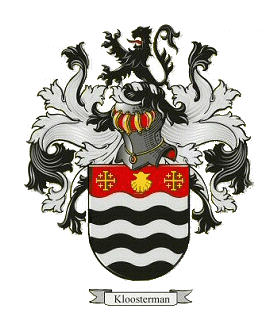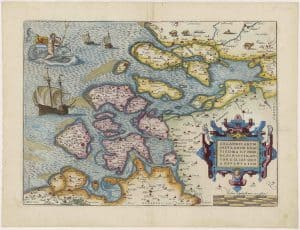In heraldry and heraldic vexillology, a blazon is a formal description
of a coat of arms, flag or similar emblem, from which the reader
can reconstruct the appropriate image.

As depicted below, a “coat of arms” consists of several parts: the shield, the mantling, the helm, the wreath, charges, and the crest (note that not all arms have crests). The official, written description of the coat of arms is called the “blazon of arms.” The blazon may seem like a foreign language, but it is simply a system of code words to denote colors, placement, and styling by using an economy of words.
The term “blason”, by which the science of heraldry is denoted in French, English, Italian, and German, is probably derived from the German word “blazen” — to blow the horn. This knowledge of the various devices and symbols was called Heraldry, and as the announcement was accompanied with the sound of a trumpet, it was termed “blazoning the arms.” A blazon of arms is the description of the arms in heraldic terms.
The earliest coats of arms were fairly simple — bars or wavy lines, a lion rampant or an eagle displayed, or an arrangement of fleurs-de-lis. The designs became more complex as the years passed, and the practice of quartering (incorporating the arms of other families acquired through marriages) developed. Regardless of their origins, coats of arms became military status symbols, and their popularity increased along with the popularity of the tournament, which was developed in the mid-eleventh century in France.
The earliest coats of arms were fairly simple — bars or wavy lines, a lion rampant or an eagle displayed, or an arrangement of fleurs-de-lis. The designs became more complex as the years passed, and the practice of quartering (incorporating the arms of other families acquired through marriages) developed. By 1400 A.D., bearing a coat of arms had become a prerequisite to participation in a tournament, and due to the importance of social standing in such pageants, a coat of arms also became a mark of noble status.
Much of the printed design for a given coat of arms is more the artist’s preference or the style of a particular herald, and not a part of any particular blazon. The mantling and the banners for names and mottoes, for example, are not an official element of the blazon of arms. The helm, likewise, is not a part of the official blazon. Some historians attach a significance to the design of the helm or helmet as representative of a certain century or social status, but there are differences of opinion on this matter.
Shield, also known as an escutcheon:
The colors and charges (lions, designs, etc. that appear on the shield) are a part of the official blazon,
but the shape of the shield is not. Shield shapes vary according to the geographical origin as well as the time period.
Crest:
The origins of the crest go back as far as classical antiquity, where its purpose was to make the warrior look taller and frighten the enemy. In the middle ages this function became less important and the crest turned into an ornament, usually made of leather or light wood.
Initially, crests were changed on a whim and as the bearer desired; often a different crest was used for every tournament. Gradually the crests became fixed, and eventually formed part of the inherited arms
(Note that there is not always a crest for every coat of arms.)
Wreath:
Not a part of the official blazon, the wreath usually consists of the primary color and metal. The wreath (also known as crest-wreath or torse) is a twisted piece of cloth in two or more colours. Its purpose was simply to hold the mantling in place, and often also hid the spot where the crest was fastened to the helmet. The colours of the wreath generally reflect the main colours of the bearer’s arms.
Helm:
Not a part of the official blazon, the helmet varies with the bearer’s rank,
the century represented, or the herald’s or artist’s preference
Mantle/Mantling:
Not a part of the official blazon (except that sometimes the colors are specified),
the design varies with the herald’s or artist’s preference.
This is said to represent the cloth that hung from the wreath and protected
the back of the head and neck, even though it may
often be depicted more like the leaves of a plant.
Colors used in shields
The colours used in heraldry, known as tinctures, all have peculiar names. There are two metals, or and argent, or gold and silver, and normally shown as yellow and white. Furs include ermine and sable (black), and colours include gules (red), azure (blue), and vert (green).
The Rule of Tincture states that no colour may be placed on a colour, no metal on a metal, and no fur on a fur, with certain exceptions. It should be noted that colours can be placed side-by-side – the rule is merely that, for example, a red charge cannot be placed on a green field.
| COLORS | Even the colors can have special meaning in a “family crest” or coat of arms: |
| Gold (Or) | Generosity and elevation of the mind |
| Silver or White (Argent) | Peace and sincerity |
| Red (Gules) | Warrior or martyr; Military strength and magnanimity |
| Blue (Azure) | Truth and loyalty |
| Green (Vert) | Hope, joy, and loyalty in love |
| Black (Sable) | Constancy or grief |
| Purple (Purpure) | Royal majesty, sovereignty, and justice |
| Orange (Tawny or Tenne) | Worthy ambition |
| Maroon (Sanguine or Murray) | Patient in battle, and yet victorious |






